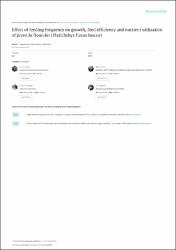Effect of feeding frequency on growth, feed efficiency and nutrient utilization of juvenile flounder (Platichthys flesus luscus)
Citation
Kucuk, E., Aydin, I., Polat, H., Eroldogan, O.T., Sahin, T. (2014). Effect of feeding frequency on growth, feed efficiency and nutrient utilization of juvenile flounder (Platichthys flesus luscus). Aquaculture International, 22(2), 723-732. https://doi.org/10.1007/s10499-013-9701-2Abstract
An experiment was conducted to determine the effects of optimal feeding frequency on growth performance, feed efficiency, nutrient utilization and body composition in juvenile flounder. Four feeding frequencies of one (F1), two (F2), three (F3) and four (F4) times a day were evaluated as treatments in triplicate for a period of 60 days. Forty-seven hatchery produced juveniles (2.5 +/- A 0.7 g) were stocked into 160-L rectangular fiberglass tanks and fed with a commercial diet containing 54 % protein to satiation. At the end of the experiment, the final weight of F1, F2, F3 and F4 were 5.06 +/- A 0.29, 5.91 +/- A 0.42, 6.24 +/- A 0.42 and 6.16 +/- A 0.46 g, respectively. Growth rates and feed consumption were highest in F3 and lowest in F1. Feed conversion ratios ranged between 0.83 +/- A 0.04 and 0.90 +/- A 0.03. There were no significant differences in either moisture or ash content of the fish groups. Protein content decreased with increasing feeding frequency, while lipid content partly increased with increasing feeding frequency. Nitrogen intake and lipid intake were significantly higher in fish fed under F3 and F4 treatment, whereas the nitrogen gain decreased and lipid gain increased with increasing feeding frequency. It is concluded that the flounder juveniles can achieve maximum growth performance and better nutrient utilization when they are fed a given ration two times a day. the findings have practical significance toward establishing an appropriate flounder nursery rearing and will directly benefit the nursery operations.


















